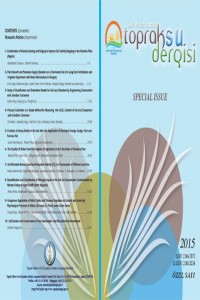Combination of remote sensing and kriging to improve soil salinity mapping in the Hmadna plain (Algeria)
Abstract
The plain of Hmadna is located in the western part of the plains of Cheliff (North-western of Algeria)
with a surface of more than 10,000 ha. The salinity mapping at the scale of whole plain is difficult to be
performed because it would be necessary to collect and analyse a large number of samples in order to
reach a good spatial estimate. The satellite's remote–sensing capability, with the quantity of information
which it offers and its broad field of view, seems to be the most suitable tool to chart salinity, when the
spectral data are combined with a reduced number of soil samples., The necessary precondition for the
operational use of this technique is the existence of a good correlation between the data measured
directly from soil samples with that resulting from the remote-sensing. The objective of this work is to
show the importance of using optical sensors with a very high spatial and spectral resolution in the
improvement of the mapping surface layer soil salinity. In the first part of this paper we develop a
relationship between the remote-sensed data (very high resolution) and the measured salinity of ground
samples (as expressed by sample electrical conductivity (EC), through statistical analysis (Ordinary Kriging)
to create a salinity index just in the sample area for this dataset. Then in the second part of the paper, we
apply this developed relationship to the whole of the WorldView-2 image set, to extrapolate a soil salinity
map for the whole area.
Keywords
Combination of remote sensing and kriging to improve soil salinity mapping in the Hmadna plain (Algeria)
Abstract
The plain of Hmadna is located in the western part of the plains of Cheliff (North-western of Algeria)
with a surface of more than 10,000 ha. The salinity mapping at the scale of whole plain is difficult to be
performed because it would be necessary to collect and analyse a large number of samples in order to
reach a good spatial estimate. The satellite's remote–sensing capability, with the quantity of information
which it offers and its broad field of view, seems to be the most suitable tool to chart salinity, when the
spectral data are combined with a reduced number of soil samples., The necessary precondition for the
operational use of this technique is the existence of a good correlation between the data measured
directly from soil samples with that resulting from the remote-sensing. The objective of this work is to
show the importance of using optical sensors with a very high spatial and spectral resolution in the
improvement of the mapping surface layer soil salinity. In the first part of this paper we develop a
relationship between the remote-sensed data (very high resolution) and the measured salinity of ground
samples (as expressed by sample electrical conductivity (EC), through statistical analysis (Ordinary Kriging)
to create a salinity index just in the sample area for this dataset. Then in the second part of the paper, we
apply this developed relationship to the whole of the WorldView-2 image set, to extrapolate a soil salinity
map for the whole area.
Keywords
Details
| Primary Language | English |
|---|---|
| Journal Section | Articles |
| Authors | |
| Publication Date | January 31, 2015 |
| Published in Issue | Year 2015 Special Issue |
Cite
Cited By
Performance of random forest and buffer analysis of Sentinel-2 data for modelling soil salinity in the Lower-Cheliff plain (Algeria)
International Journal of Remote Sensing
Ibrahim Yahiaoui
https://doi.org/10.1080/01431161.2020.1823515
Soil salinity: A global threat to sustainable development
Soil Use and Management
https://doi.org/10.1111/sum.12772
A DIACHRONIC ANALYSIS OF THE VEGETATION COVER IN A SPATE IRRIGATION PERIMETER – CASE STUDY: THE EL FEIDH REGION, BISKRA, ALGERIA
Revue Roumaine de Géographie / Romanian Journal of Geography
https://doi.org/10.59277/RRG.2025.1.06
Grafik Tasarım : Filiz ERYILMAZ
Basım Yeri : Gıda Tarım ve Hayvancılık Bakanlığı - Eğitim Yayım ve Yayınlar Dairesi Başkanlığı
İvedik Caddesi Bankacılar Sokak No : 10 Yenimahalle, Ankara Türkiye

